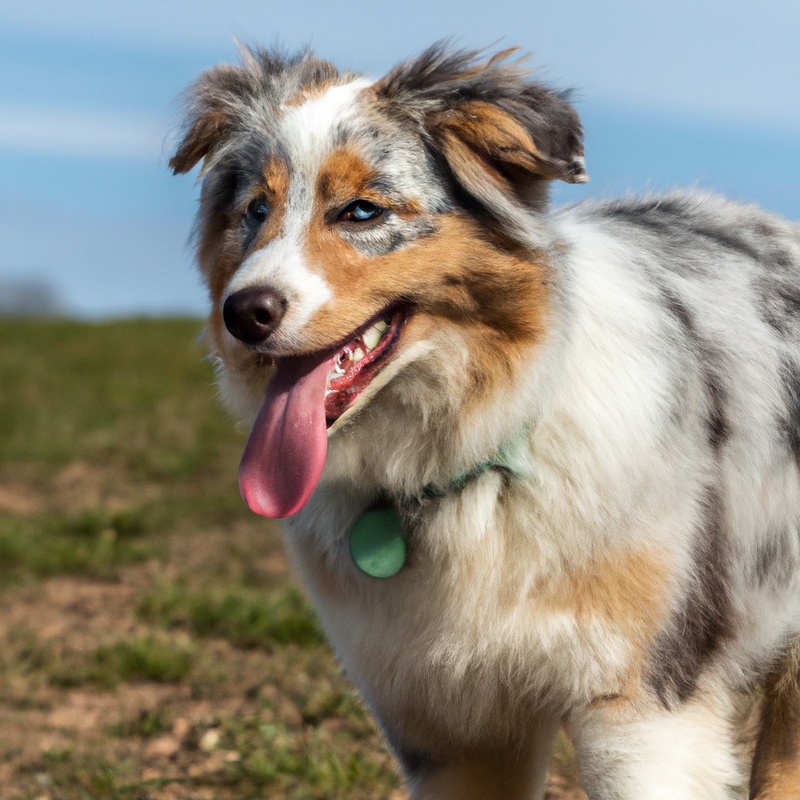Can Australian Shepherds Be Trained To Be Good With Wildlife Like Deer Or Rabbits?
Key Takeaways:
- Australian Shepherds can be trained to coexist peacefully with wildlife like deer or rabbits.
- Proper training and socialization are crucial to help Australian Shepherds develop positive interactions with wildlife.
- Consistent reinforcement and positive rewards can encourage Australian Shepherds to exhibit appropriate behavior around deer or rabbits.
- However, some individual dogs may have a stronger prey drive, making it more challenging to train them to ignore or peacefully coexist with wildlife.
Are you a nature lover who also happens to be the proud owner of an Australian Shepherd? If so, you may find yourself wondering if your furry friend can coexist peacefully with the wildlife that surrounds you.
Well, you’re in luck because I’m here to shed some light on the topic.
As an experienced dog trainer and wildlife enthusiast, I’ve witnessed firsthand the incredible potential of Australian Shepherds to live harmoniously with animals like deer and rabbits. In this article, we’ll explore the factors to consider, techniques to employ, and precautions to take when training your Australian Shepherd to be a wildlife-friendly companion.
Let’s dive in!
| Topics | Answer |
|---|---|
| Can Australian Shepherds be trained to be good with wildlife like deer or rabbits? | Yes, Australian Shepherds can be trained to be good with wildlife like deer or rabbits, but it requires proper training and socialization from a young age. |
Factors to Consider when Training Australian Shepherds with Wildlife
Understanding the Natural Instincts of Australian Shepherds
Understanding the Natural Instincts of Australian Shepherds Australian Shepherds have strong herding instincts due to their history of working with livestock. They are known for their high energy levels, intelligence, and problem-solving abilities.
These natural instincts can play a role when training them to coexist with wildlife.
It’s essential to recognize and understand these instincts in order to effectively train Australian Shepherds with wildlife. One of their primary instincts is to chase and control movement.
This instinct can cause them to chase after wildlife such as deer or rabbits.
By acknowledging this instinct, we can develop training techniques that redirect their focus to more appropriate behaviors. Another instinct is their strong prey drive.
Australian Shepherds may have a natural inclination to chase and catch smaller animals.
This instinct can be managed through consistent training, socialization, and positive reinforcement. Additionally, Australian Shepherds have a protective nature towards their family and territory.
While this can be beneficial in certain situations, it may lead to territorial aggression towards wildlife.
Proper socialization and training can help them develop positive associations with wildlife and reduce aggressive behaviors. By understanding these natural instincts, we can tailor our training methods to address them effectively.
Training should focus on redirecting their herding instincts, managing prey drive, and promoting positive associations with wildlife.
With patience, consistency, and positive reinforcement, Australian Shepherds can be trained to coexist harmoniously with wildlife.
Assessing the Dog’s Temperament and Drive
Assessing the dog’s temperament and drive is a key step in training Australian Shepherds to coexist with wildlife. It’s important to evaluate their natural instincts and behavior towards animals.
Look for signs of prey drive, such as chasing or herding tendencies.
Assess their reaction to wildlife, including their level of curiosity or aggression. A dog with a calm and responsive temperament may be easier to train.
Understanding your dog’s individual traits will help you tailor your training methods and set realistic expectations for their behavior around wildlife.

Socializing Australian Shepherds with Wildlife
When it comes to socializing Australian Shepherds with wildlife, it’s important to start early and expose them to different animals in a controlled environment. This will help them develop positive associations and reduce the likelihood of aggressive behavior.
Some key tips for socializing Australian Shepherds with wildlife include:
- Start with controlled introductions: Begin by exposing your Australian Shepherd to wildlife in a controlled environment, such as a fenced yard or on-leash walks. This allows them to observe and interact without feeling threatened.
- Gradual exposure: Slowly introduce your dog to different types of wildlife, starting with smaller and less intimidating animals. As they become more comfortable, you can gradually expose them to larger or more exciting animals.
- Positive reinforcement: Use positive reinforcement training methods, such as treats and praise, to reward your Australian Shepherd for calm and appropriate behavior around wildlife. This helps to reinforce positive associations and encourages them to behave positively in future interactions.
- Supervision: Always supervise your Australian Shepherd when they are around wildlife. This allows you to intervene if necessary and ensures the safety of both your dog and the wildlife.
- Consistency: Consistency is key when socializing Australian Shepherds with wildlife. Regularly expose them to different animals and reinforce positive behavior consistently. This helps them understand what is expected of them and reinforces appropriate behavior.
Remember, each dog is unique, and some Australian Shepherds may have a stronger prey drive than others. It’s important to assess your dog’s temperament and adjust your training approach accordingly.
Consult with a professional dog trainer if necessary for guidance and support in socializing your Australian Shepherd with wildlife.

Techniques to Train Australian Shepherds to Coexist with Wildlife
Positive Reinforcement Training Methods
Positive reinforcement training methods are highly effective when it comes to training Australian Shepherds to coexist with wildlife. These methods involve rewarding desired behaviors with treats, praise, or play, which encourages the dog to repeat those behaviors.
Here are some positive reinforcement techniques you can use:
- Reward-based training: Use treats, toys, or verbal praise to reward your Australian Shepherd whenever they display calm and appropriate behavior around wildlife. This reinforces the idea that good behavior leads to positive outcomes.
- Clicker training: Using a clicker device, you can make a distinct clicking sound whenever your dog exhibits a desired behavior. This sound serves as a marker that indicates to your dog that they will receive a reward. Over time, your dog will associate the click with a treat or praise.
- Target training: Teach your Australian Shepherd to focus their attention on a specific object, such as a stick or a target stick. By redirecting their attention towards the target, you can help them stay calm and focused in the presence of wildlife.
- Capturing calm behavior: Whenever your Australian Shepherd displays calm behavior around wildlife, such as sitting or lying down, immediately reward them. This reinforces the idea that staying calm has positive outcomes.
By using positive reinforcement training methods, you can effectively teach your Australian Shepherd to coexist peacefully with wildlife. Remember to be patient, consistent, and always reward desired behaviors.
Teaching Basic Commands for Wildlife Interaction
Teaching basic commands to your Australian Shepherd is essential for their safe interaction with wildlife. Start with important commands like “Leave it” to prevent them from chasing or approaching wildlife.
“Stay” and “Come” commands will help you have control over their movements and keep them from getting too close or running away.
Reinforce these commands with positive rewards and consistent training sessions. Practice these commands in controlled environments and gradually introduce them to wildlife areas.
Consistency and patience are key to teaching these basic commands effectively to ensure a harmonious coexistence between your Australian Shepherd and wildlife.

Implementing Desensitization and Counterconditioning Techniques
Implementing desensitization and counterconditioning techniques is key to training Australian Shepherds to coexist peacefully with wildlife. Desensitization involves gradually exposing your dog to wildlife in a controlled and safe environment, starting with low-intensity encounters and gradually increasing difficulty.
Counterconditioning focuses on changing your dog’s emotional response to wildlife by associating positive experiences and rewards with their presence.
To implement desensitization, start by introducing your dog to wildlife sights, sounds, and smells from a distance. Gradually decrease the distance between your dog and the wildlife, ensuring that they remain calm and relaxed throughout the process.
Reward your dog with treats, praise, and play when they exhibit calm behavior.
Counterconditioning involves creating positive associations with wildlife. Use high-value treats or toys to reward your dog for remaining calm and relaxed in the presence of wildlife.
Over time, your dog will begin to associate the presence of wildlife with positive experiences, rather than excitement or aggression.
Remember, desensitization and counterconditioning require patience and consistency. It’s important to progress at a pace that is comfortable for your dog, ensuring their emotional well-being throughout the training process.
Seek guidance from a professional dog trainer if needed, who can provide further techniques and support.
Precautions to Take when Training Australian Shepherds with Wildlife
Monitoring and Supervision in Wildlife-Friendly Areas
When training Australian Shepherds to coexist with wildlife, monitoring and supervision in wildlife-friendly areas is essential. You want to ensure the safety of both your dog and the wildlife.
By being vigilant and aware of their interactions, you can prevent any unwanted or risky behavior.
Regularly check the area for any signs of wildlife, such as tracks or droppings. Keep your dog on a leash and closely supervise their behavior.
If you notice any signs of aggression or excessive interest in the wildlife, redirect your dog’s attention and reinforce positive behaviors.
It’s important to create a calm and controlled environment to minimize any potential harm to wildlife and keep everyone safe.
Ensuring Secure Fencing and Boundaries
When it comes to training Australian Shepherds to coexist with wildlife, ensuring secure fencing and boundaries is important. These dogs have a strong prey drive, so it’s crucial to have proper fencing in place to prevent them from chasing after wildlife.
Make sure that the fence is tall enough to prevent jumping or climbing over and that there are no gaps or holes for them to slip through.
Additionally, it’s a good idea to reinforce the bottom of the fence to prevent digging. By taking these precautions, you can create a safe and secure environment for both your Australian Shepherd and the wildlife they may encounter.
Consulting with Wildlife Experts and Professionals
Consulting with wildlife experts and professionals is essential when training Australian Shepherds to coexist with wildlife. These experts have the knowledge and experience to guide you on the best practices and techniques for wildlife training.
They can provide valuable insights into the natural behaviors and instincts of the wildlife in your area, helping you tailor your training approach accordingly.
Additionally, they can offer advice on creating safe and secure environments for both your dog and wildlife. Reach out to local wildlife conservation organizations, wildlife rehabilitators, or professional dog trainers specialized in wildlife training to seek their expertise and ensure a successful training journey for your Australian Shepherd.
Further Resources for Training Australian Shepherds with Wildlife
Books and Online Resources on Wildlife Training for Dogs
If you’re looking for books and online resources on wildlife training for dogs, there are plenty of options available. Here are a few recommendations:
- “Wildlife-Friendly Dog Training” by Patricia McConnell: This book provides practical tips and techniques for training dogs to coexist peacefully with wildlife. McConnell’s expertise in animal behavior makes this a valuable resource.
- “Coexisting with Wildlife: A Guide to Wildlife Training for Dogs” by Casey Anderson: Anderson, a wildlife expert, offers insights and strategies for training dogs to behave appropriately around wildlife. His experience working with animals adds credibility to his advice.
- “Online Resources for Wildlife Training” at WildlifeTraining.com: This website offers a wealth of information on training dogs to peacefully interact with wildlife. You’ll find articles, videos, and step-by-step guides to help you navigate the training process.
- “Wildlife Training Tips” YouTube channel: This channel features videos with practical tips and demonstrations for training dogs to behave responsibly around wildlife. It’s a great visual resource to complement your training efforts.
Remember, when using online resources, it’s important to verify the expertise and credibility of the sources. Look for recommendations from reputable organizations and professionals in the field of wildlife training and behavior.
Happy training!
Professional Dog Trainers Specialized in Wildlife Training
If you’re looking for a professional dog trainer who specializes in wildlife training, you’re in luck! There are trainers out there who have specific expertise in training dogs to coexist peacefully with wildlife. These trainers have a deep understanding of both canine behavior and wildlife behavior, allowing them to create training programs that promote safe and harmonious interactions between dogs and wildlife.
When searching for a professional dog trainer specialized in wildlife training, it’s important to find someone with a proven track record in this specific area.
Look for trainers who have successfully trained dogs to behave appropriately around wildlife such as deer or rabbits. They should have experience in implementing positive reinforcement techniques, desensitization and counterconditioning, and teaching dogs basic commands for wildlife interaction.
A good starting point in your search for a professional wildlife dog trainer is to ask for recommendations from your local animal control office, wildlife conservation organizations, or even local veterinarians.
These professionals often have connections with trainers who specialize in wildlife training and can provide you with valuable referrals. You can also utilize online resources such as professional directories and forums specifically focused on dog training to find trainers with wildlife specialization.
Look for trainers who have certifications or memberships with reputable organizations such as the Certification Council for Professional Dog Trainers (CCPDT) or the International Association of Animal Behavior Consultants (IAABC).
These credentials indicate that the trainer has met certain standards of knowledge and skill in dog training. When reaching out to potential trainers, be sure to ask questions about their experience with wildlife training, their training methods, and their success stories in this area.
It’s crucial to find a trainer who not only has the knowledge but also the practical experience in wildlife training to ensure the best results for you and your Australian Shepherd.
Remember, finding a professional dog trainer specialized in wildlife training may take some time and research, but it’s well worth the effort for the safety and well-being of your dog and the wildlife around you.
Final Verdict
Australian Shepherds can absolutely be trained to coexist with wildlife such as deer or rabbits. By understanding their natural instincts, assessing their temperament and drive, and socializing them properly, we can lay the foundation for successful training.
Positive reinforcement methods, teaching basic commands, and implementing desensitization techniques are effective tools to train these dogs.
However, precautions must always be taken to ensure the safety of both the dog and the wildlife, such as monitoring, secure fencing, and consulting with wildlife experts. By following these guidelines and utilizing the available resources, we can cultivate a harmonious relationship between Australian Shepherds and wildlife.







